- An exclusive Mongabay interview with University of Washington researcher Samantha Zwicker.
- Zwicker’s game camera research is documenting the responses of Peruvian cats and other mammals to road network expansion, selective timber logging, and the clearing of forests for cacao plantations.
- Such baseline research can offer important data to better understand wildlife dispersal and gene flow throughout the region, and for delineating future protected areas and wildlife corridors, along with other conservation goals.
The dense undergrowth of tropical forests presents a mysterious prospect to wildlife researchers. Often what is easily spotted does not represent the whole, and scientists in the past could spend months, or even years, studying a species before ever observing it. Now traditional data collection methods are being augmented by advanced technologies such as camera traps — motion sensitive still and video cameras that can unobtrusively capture animal behavior.
Samantha Zwicker is a Masters student and PhD candidate in the School of Environmental and Forest Sciences at the University of Washington (UW). Under the guidance of her adviser, Dr. Kristiina Vogt, she is using camera traps to analyze animal behaviors as they are impacted by human presence and development in one of the wildest parts of Peru. Samantha’s project was supported by the Student Technology Fee Committee at UW. The committee provided her with 150 camera traps in response to her grant proposal.
Her study, as featured in the institute’s bulletin, focused on four indigenous cat species and the factors dependent on their movement, including land use, habitat type and distance from human activity.

In this exclusive interview with Mongabay, Samantha Zwicker explains the unique aspects of her work:
Mongabay: What attributes of your study do you consider revolutionary?
Samantha Zwicker: Most camera trapping studies take place in parks, reserves, and sanctuaries because these areas are more accessible, well studied, and the cameras are less vulnerable to theft. My investigation is revolutionary in conservation research for several reasons. This study is both globally important and locally novel, as there are no published studies on carnivores in [Peru’s] Piedras region.
While the majority of camera trapping studies, and mammal studies, are conducted within reserve or park borders, my work is based in the Piedras region of Madre de Dios, Peru, an unprotected biodiversity hotspot situated between parks like Manu, Tambopata, and Alto Purus.
This region is undergoing increasing land use changes with unknown adverse impacts on wildlife. Hence, monitoring [mammals] in unprotected areas offers a vital comparative view.
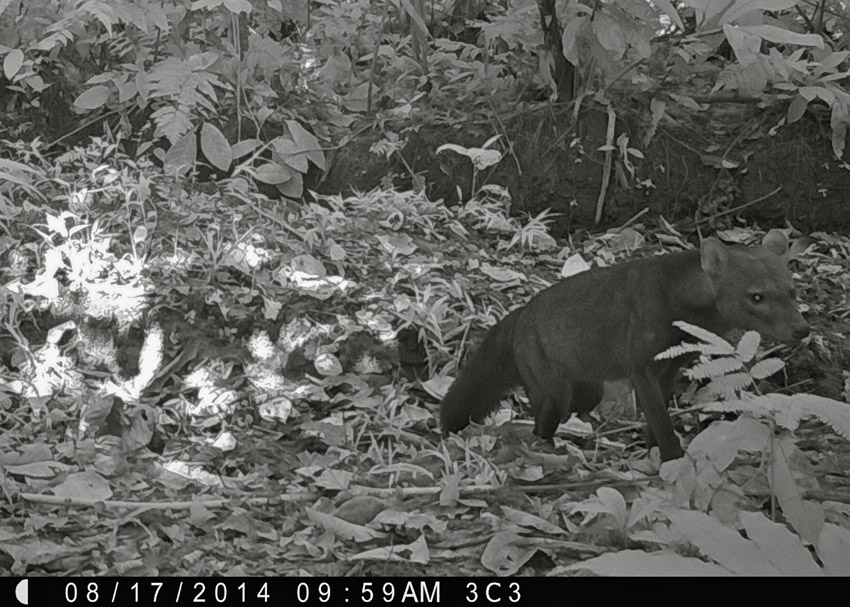
Mongabay: What has been the focus of your work so far in Peru?
Samantha Zwicker: My previous research was focused on creating a mammal inventory and overall assessment of human impact on mammal presence and density. Currently, my work is more rigorous and wide-scale. Camera trapping methods are used to capture jaguars, specifically in order to get accurate density estimates in Madre de Dios.
Mongabay: What approaches were previously used for gathering wildlife data? And, how has camera trap technology improved upon that?
Samantha Zwicker: Other mammal survey methods include in situ surveys and transects, scat collection, track traps and radio collaring.
Camera trapping is a unique method for monitoring wildlife populations because it is non-invasive, requires low personnel demand, and allows unbiased indicator estimation in remote areas. Camera trapping can also identify individuals of a particular felid species by [the pattern of their] spots and [location of] botfly warbles [swellings under the skin caused by parasites].
However, camera trapping has yet to be used as a primary method for monitoring mammal populations in response to human impacts. Camera traps usually use infrared flash of around 800 nm [nanometers], a spectral output not disruptive to most wildlife. This makes these cameras ideal for capturing authentic animal behaviors day and night, since most tropical mammals are diurnal or nocturnal.
This method can be used in lieu of, or congruently, with common wildlife inventory methods including interviews with local people, direct observations, and line transect, trapping and tagging, as well as identification of tracks and feces.
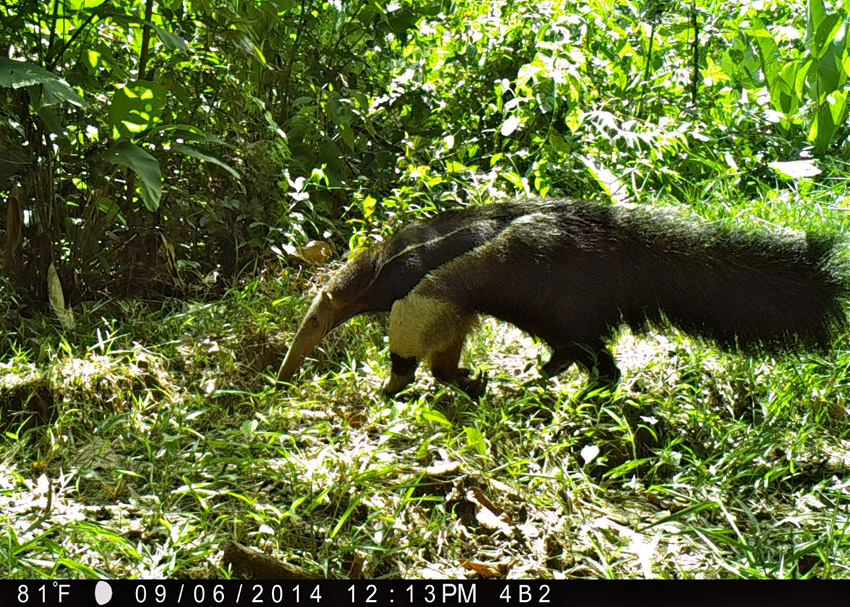
Mongabay: How long has camera trap technology been used to study animals?
Samantha Zwicker: Camera trapping has been in practice for about 15 years. The technology has improved greatly in the last five years, as cameras are now being developed with black infrared flash, HD video, and far more settings options.
Mongabay: Have you been able to record rare species of animals in your work?
Samantha Zwicker: I’ve caught many rare and elusive species on camera trap including the giant armadillo (Priodontes maximus), short-eared dog (Atelocynus microtis), bush dog (Speothos venaticus), jaguarondi (Puma yagouarundi), and pacarana (Dinomys branickii).
I was able to capture many IUCN threatened species as well. IUCN threatened species are those considered Critically Endangered, Endangered, or Vulnerable worldwide, and included the pacarana (Dinomys branickii), giant armadillo (Priodontes maximus), jaguar (Panthera onca), margay (Leopardus wiedii), short-eared dog (Atelocynus microtis), bush dog (Speothos venaticus), and lowland tapir (Tapirus terrestris).
The list of threatened species in Peru differs only slightly; it includes all of the above IUCN threatened species, plus the puma (Puma concolor) and ocelot (Leopardus pardalis). My favorite picture is that of three bush dogs, disproving the belief that they aren’t present in the [Las Piedras] region!
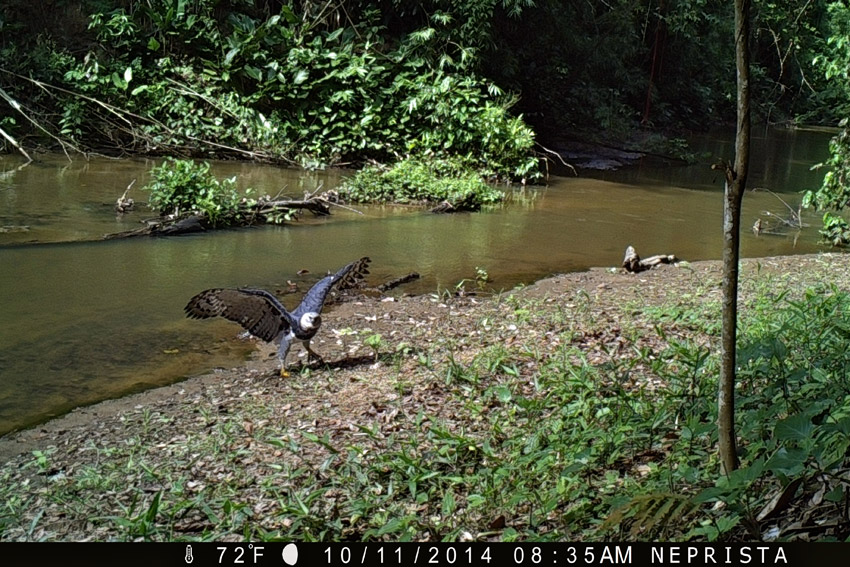
Mongabay: What are the drawbacks of this technique and your plans to improve upon it?
SZ: Camera trapping is invaluable for monitoring wildlife, and the use of cameras will only increase. However, I do think that [the technique] could and should be combined with other surveying methods to create a larger, more robust dataset with even more accurate results and estimations. I hope to combine camera trapping with other methods in the near future, specifically scat and track surveys.
Mongabay: What is your vision for your camera traps work in Piedras?
Samantha Zwicker: Larger mammals such as jaguar are moving between the parks using the Piedras as a corridor. The viability and quality of this corridor over time, however, is not secure. As road networks are created and people continue to immigrate farther into the lowland rainforests, the future of a protected corridor or park becomes less feasible and less necessary as wildlife populations decrease.
This is why I want to continue my research in the Piedras — it’s a vital and special place for conservation in the context of diversity and vulnerability. It represents one of the largest unprotected and most intact tropical rainforests in Peru. My research shows both the importance of the region in supporting robust felid populations, and the urgency [for increasing] protection of the region’s species and forests.
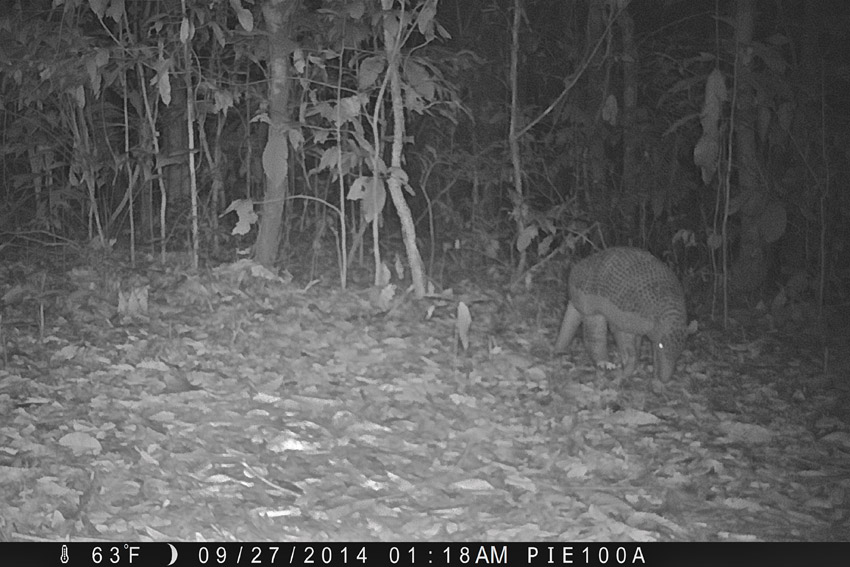
Mongabay: Your work is linked to human development. Could you explain that concept further?
Samantha Zwicker: Deforestation in the Piedras has been caused by a number of factors such as expanding road networks, selective timber logging, and agriculture. Forests are being cleared to give way to cacao plantations — a widespread phenomenon in the region.
To avoid further clearing of forests, I initiated a non-profit and experimental center called Hoja Nueva, along with my colleague, Melanie Desch. We promote community development, permaculture, conservation, and research efforts in the Piedras. We are growing eco-friendly cacao in a cost-effective manner so that our sustainable methods like biochar, composting, and water collection/filtration can be replicated by surrounding communities. In many places, conservation science and management goes hand in hand with sustainable community development.
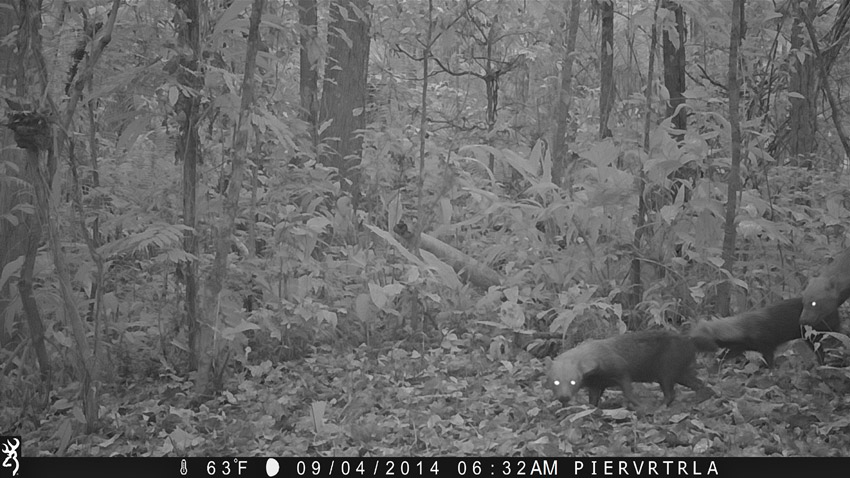
Samantha Zwicker sees her work as providing an invaluable baseline for the long-term monitoring of mammal abundance and diversity to help plan for the regional conservation of threatened species, particularly cats. Top predators serve as good indicator species for the health and biodiversity of an ecosystem or region, she says. Her project is designed to offer a better understanding of local felids, and the impacts on wildlife of regional Land-Use and Cover-Change (LUCC) within and around Las Piedras.
She emphasizes the importance of socioeconomic and political factors in the management of LUCC in the Madre de Dios region at the local, regional and national level. The success of her survey in evaluating the influence of land-use activities on mammals in Las Piedras could lead to improved conservation policies, including use of the results to delineate protected areas and wildlife corridors. This could lead to better wildlife dispersal and gene flow throughout the region, and better protection of local populations from hunting and other human disturbances.


An ocelot kitten (Leopardus pardalis) follows closely behind its mother on an active logging road. This adult female has been captured on camera eight separate times on ARCAmazon lands, suggesting that she and her kitten take refuge within its borders. Video by Samantha Zwicker.
Editor’s note:
The first three photos above are from the Manu a Tambopata (MAT) corridor along the interoceanic highway. Samantha assisted Dr. Jason Scullion with his PhD project with Asociación para la Conservación de la Cuenca Amazónica (ACCA) to help monitor wildlife behavior in response to the highway. Dr. Scullion is the President of Wild Forests and Fauna (WFF).
Samantha said she mainly worked out of ARCAmazon this past summer, an organization neighboring her organization, Hoja Nueva, in the Piedras. ARCA protects 4,460 hectares of forested conservation area. The organization is funded by WFF and she said they were very supportive with both her master’s and PhD studies, as was Fauna Forever. Samantha believes they are all doing amazing things for conservation in the Amazon and working to raise awareness worldwide.
Citation:
Becker, M. (2015). Cameras and Conservation: How Camera Trapping is Revolutionizing Research in Madre de Dios Peru. In: Photographic Sciences Bulletin (Cameras and Conservation). Rochester Institute of Technology.
